Custom Form Delivery
One of our customers recently requested a change to how they logged Swans. There were areas of the airfield where Mute and Whooper Swans were occasionally seen but as taking any control action was not permitted, they still wanted to log that the Swans were there. Also and more importantly, they wanted to ensure that was the only logging option so it was clear for the wildlife team.
To this end, we built a new “Observed” form containing just the 3 areas covered and the 2 species. We updated our system so we were able to push it remotely to their logging devices and so they didn’t have to do anything at their end. This worked beautifully and they’ve submitted over 100 observed logs to the system so far since receiving it.
This is such a useful function for us that we’ve now made it a mainstream feature of the system. We’re pleased to announce that the latest version of the Android App (v1.6) adds support for this. As every airport is different, we think this ability is a huge benefit. If you discover you have any custom logging requirements while using the system, just let us know.


